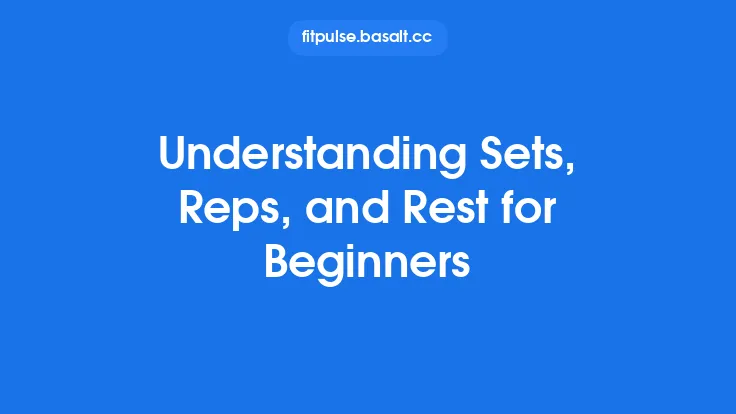When it comes to squeezing every possible ounce of strength out of a training session, traditional straight‑set schemes often leave room for improvement. Two of the most potent tools in the advanced lifter’s toolbox are cluster sets and rest‑pause methods. Both techniques manipulate intra‑set rest intervals to boost mechanical tension, motor‑unit recruitment, and metabolic stress—key drivers of strength adaptations—while allowing lifters to handle heavier loads than would be possible with conventional rep schemes.
What Are Cluster Sets?
A cluster set breaks a traditional set into several mini‑sets (or “clusters”) separated by short, planned rest periods, typically ranging from 10 to 30 seconds. The total number of repetitions performed across the clusters equals the target rep range, but the brief rests enable the athlete to maintain a higher bar speed and better technique throughout the entire effort.
Typical structure
| Cluster Set Example | Load (% 1RM) | Reps per Cluster | Rest Between Clusters |
|---|---|---|---|
| 4 × 3 + 2 + 1 + 1 | 85–90% | 3, 2, 1, 1 | 15 s |
| 5 × 2 + 2 + 2 + 2 + 2 | 80% | 2 each | 20 s |
The exact configuration can be tailored to the exercise, training goal, and the athlete’s experience level.
Why They Work
- Enhanced Motor‑Unit Recruitment – The brief rests prevent premature fatigue of high‑threshold motor units, allowing repeated activation of the strongest fibers across the entire set.
- Preserved Bar Velocity – Maintaining a faster concentric phase improves the neural drive and reinforces the skill of moving heavy loads explosively.
- Greater Mechanical Tension – By using heavier loads for a given volume, the muscle experiences higher peak tension, a primary stimulus for strength gains.
- Reduced Metabolic Accumulation – Short rests limit the buildup of lactate and hydrogen ions, which can otherwise impair force production.
Rest‑Pause Method Explained
Rest‑pause training also inserts intra‑set rest, but the pattern differs. After reaching near‑failure on a set, the lifter rests for a very brief interval (usually 10–20 seconds), then performs additional repetitions with the same load. This “pause‑and‑go” cycle can be repeated multiple times within a single set.
Typical protocol
- Initial Set: Perform 6–8 reps to near‑failure (≈ 80–85% 1RM).
- First Pause: Rest 15 seconds.
- Mini‑Set 1: Perform 2–3 reps.
- Second Pause: Rest another 15 seconds.
- Mini‑Set 2: Perform 1–2 reps.
The total rep count often exceeds the conventional set, but the load remains constant, forcing the nervous system to sustain high‑threshold recruitment despite accumulating fatigue.
Mechanistic Benefits
- Extended Time‑Under‑Tension – The cumulative work time is longer, amplifying the stimulus for strength adaptations.
- Increased Central Drive – Repeatedly re‑engaging the motor cortex after short rests trains the nervous system to recover quickly, a valuable trait for competitive lifts.
- Psychological Toughness – The method teaches athletes to push through discomfort, improving mental resilience during maximal attempts.
Choosing Between Cluster Sets and Rest‑Pause
| Factor | Cluster Sets | Rest‑Pause |
|---|---|---|
| Primary Goal | Maximize load while preserving technique | Push beyond conventional failure for extra volume |
| Typical Load | 80–95% 1RM | 75–85% 1RM |
| Rest Interval | 10–30 s between clusters | 10–20 s after near‑failure |
| Complexity | Requires precise timing, often aided by a timer | Simpler to execute, but demands accurate perception of failure |
| Best For | Powerlifters, Olympic lifters, athletes needing high bar speed | Bodybuilders, strength athletes seeking hypertrophy‑strength hybrid stimulus |
Both methods can be incorporated within the same training block, alternating weekly or even within a single session to provide varied neural and metabolic challenges.
Programming Cluster Sets
1. Exercise Selection
- Compound lifts (squat, deadlift, bench press, overhead press) benefit most because the high loads and multi‑joint nature amplify neural recruitment.
- Accessory movements (rows, lunges, triceps extensions) can also be clustered, especially when the goal is to increase load beyond what a straight set would allow.
2. Volume & Frequency
- Strength Phase (4–6 weeks): 2–3 cluster set sessions per week per muscle group, 3–5 total clusters per exercise.
- Volume Example:
- Back Squat: 4 × (3 + 2 + 1) clusters @ 90% 1RM, 15 s rest between clusters, 3 × weekly.
- Recovery: Because the intra‑set rest reduces systemic fatigue, overall session RPE often stays moderate (6–7/10), allowing higher weekly frequency.
3. Progression Strategies
- Load Progression: Increase the bar weight by 2.5–5 kg once the athlete can complete all planned clusters with consistent bar speed.
- Cluster Density: Reduce the rest interval (e.g., from 20 s to 15 s) while maintaining load, thereby increasing the density of work.
- Cluster Volume: Add an extra mini‑set or increase reps per cluster once the current scheme becomes easy.
Programming Rest‑Pause Sets
1. Exercise Selection
- Ideal for bench press, weighted dips, leg press, and pull‑ups where the lifter can safely approach failure without catastrophic loss of form.
- Less suitable for highly technical lifts (e.g., snatch) where fatigue could compromise technique.
2. Volume & Frequency
- Strength‑Hypertrophy Hybrid Phase (3–5 weeks): 1–2 rest‑pause sets per exercise, 2–3 sessions per week per muscle group.
- Volume Example:
- Bench Press: 1 × (8 + 2 + 2) reps @ 85% 1RM, 15 s pauses, 2 × weekly.
- Recovery: The intense nature of each set often yields higher session RPE (8–9/10). Limit total rest‑pause sets per workout to 3–4 to avoid overreaching.
3. Progression Strategies
- Add Reps: Increase the number of reps in the initial set before failure (e.g., from 8 to 9) while keeping the same load.
- Decrease Pause Duration: Shorten the rest interval to 10 s, forcing faster recovery.
- Increase Load: Once the athlete can complete the full protocol with ease, bump the weight by 2.5–5 kg.
Integrating Both Methods in a Periodized Plan
While the article avoids deep discussion of periodization, a practical approach is to phase the techniques:
- Weeks 1‑3: Emphasize cluster sets on primary lifts to build high‑load capacity and bar speed.
- Weeks 4‑6: Switch to rest‑pause on the same lifts, preserving the load but adding extra reps beyond failure.
- Weeks 7‑8: Combine both—cluster the main compound, then finish with a rest‑pause accessory set—to provide a comprehensive stimulus.
This alternating pattern prevents adaptation plateaus and keeps the nervous system constantly challenged.
Monitoring Performance and Safety
| Metric | How to Track | Target Range |
|---|---|---|
| Bar Velocity | Use a linear position transducer or smartphone app | Maintain > 0.5 m/s for power‑focused clusters |
| RPE | Subjective rating after each set | 6‑8 for clusters, 8‑9 for rest‑pause |
| Reps in Reserve (RIR) | Estimate remaining reps before failure | 1‑2 RIR for clusters, 0‑1 RIR for rest‑pause |
| Joint Health | Observe technique, especially on the last mini‑set | No breakdown in form; stop if form degrades |
Because both methods push the limits of fatigue, proper warm‑up (including activation drills and progressive loading) is essential. Additionally, lifters should have a spotter or safety equipment (e.g., power rack with safety bars) when training near maximal loads.
Common Pitfalls and How to Avoid Them
- Too Long Intra‑Set Rest – Extending rest beyond 30 seconds turns a cluster into a series of separate sets, diluting the intended neural stimulus. Use a timer or audible cue.
- Neglecting Technique – The desire to “crank out” reps can lead to compromised form, especially on the final mini‑set. Prioritize quality over quantity.
- Excessive Volume – Adding clusters or rest‑pause sets on top of a high‑volume program can precipitate overtraining. Keep total weekly volume within 10–12 sets per major muscle group.
- Inconsistent Load – Switching loads between clusters defeats the purpose of maintaining high‑threshold recruitment. Stick to a single weight per set.
- Ignoring Recovery – Because these methods are neurologically demanding, adequate sleep, nutrition, and active recovery are non‑negotiable.
Practical Example: Full Upper‑Body Session
| Exercise | Set Type | Load (% 1RM) | Structure | Rest Between Sets |
|---|---|---|---|---|
| Bench Press | Cluster | 90% | 4 × (3 + 2 + 1) | 3 min |
| Bent‑Over Row | Rest‑Pause | 80% | 1 × (8 + 2 + 2) | 3 min |
| Overhead Press | Cluster | 85% | 3 × (2 + 2 + 2) | 2 min |
| Weighted Dips | Rest‑Pause | 75% | 1 × (6 + 3 + 2) | 2 min |
| Face Pulls (Accessory) | Straight Set | Light | 3 × 12 | 1 min |
This layout showcases how clusters can dominate the primary push/pull lifts, while rest‑pause adds a high‑intensity finish to a couple of key movements.
Frequently Asked Questions
Q: Can beginners use cluster or rest‑pause methods?
A: While the concepts are simple, they demand a solid foundation of technique and an understanding of personal limits. Novices should first master straight‑set execution at moderate loads before introducing intra‑set rests.
Q: How do these methods compare to traditional “drop sets”?
A: Drop sets reduce load after failure, emphasizing metabolic stress. Cluster and rest‑pause keep the load constant, targeting maximal motor‑unit recruitment and bar speed—more directly aligned with pure strength development.
Q: Do I need special equipment?
A: No. A timer (phone, watch, or interval app) is sufficient. For safety on heavy clusters, a power rack with safety pins or a competent spotter is recommended.
Q: How often should I test my 1RM when using these methods?
A: Re‑assess every 4–6 weeks, preferably after a deload week, to ensure the prescribed percentages remain accurate.
Bottom Line
Cluster sets and rest‑pause methods are powerful, evidence‑based strategies that let lifters handle heavier loads, sustain higher bar speeds, and push beyond conventional failure—all while keeping total session fatigue manageable. By manipulating intra‑set rest, athletes can fine‑tune motor‑unit recruitment, mechanical tension, and metabolic stress to accelerate strength gains. When programmed thoughtfully—respecting load, volume, and recovery—these techniques become indispensable tools for anyone serious about advancing beyond the plateau of traditional straight‑set training.





